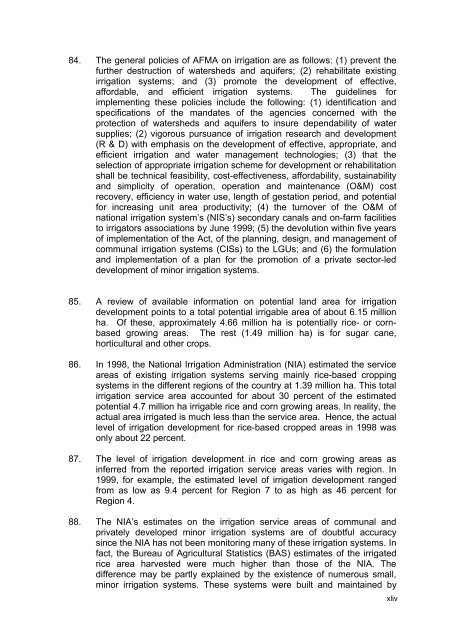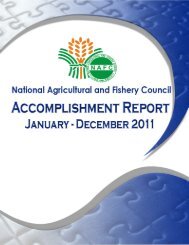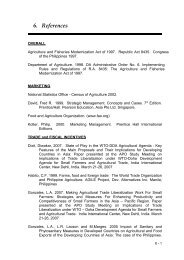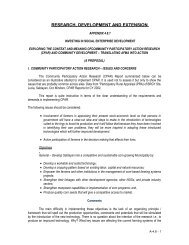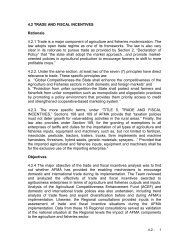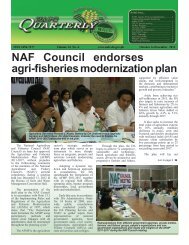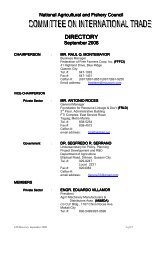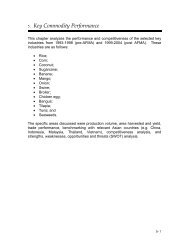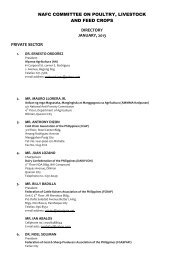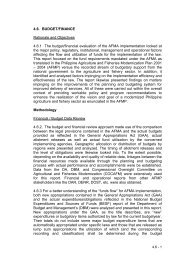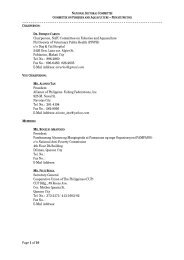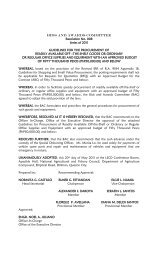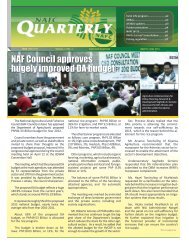EXECUTIVE SUMMARY - National Agricultural and Fishery Council ...
EXECUTIVE SUMMARY - National Agricultural and Fishery Council ...
EXECUTIVE SUMMARY - National Agricultural and Fishery Council ...
You also want an ePaper? Increase the reach of your titles
YUMPU automatically turns print PDFs into web optimized ePapers that Google loves.
84. The general policies of AFMA on irrigation are as follows: (1) prevent the<br />
further destruction of watersheds <strong>and</strong> aquifers; (2) rehabilitate existing<br />
irrigation systems; <strong>and</strong> (3) promote the development of effective,<br />
affordable, <strong>and</strong> efficient irrigation systems. The guidelines for<br />
implementing these policies include the following: (1) identification <strong>and</strong><br />
specifications of the m<strong>and</strong>ates of the agencies concerned with the<br />
protection of watersheds <strong>and</strong> aquifers to insure dependability of water<br />
supplies; (2) vigorous pursuance of irrigation research <strong>and</strong> development<br />
(R & D) with emphasis on the development of effective, appropriate, <strong>and</strong><br />
efficient irrigation <strong>and</strong> water management technologies; (3) that the<br />
selection of appropriate irrigation scheme for development or rehabilitation<br />
shall be technical feasibility, cost-effectiveness, affordability, sustainability<br />
<strong>and</strong> simplicity of operation, operation <strong>and</strong> maintenance (O&M) cost<br />
recovery, efficiency in water use, length of gestation period, <strong>and</strong> potential<br />
for increasing unit area productivity; (4) the turnover of the O&M of<br />
national irrigation system’s (NIS’s) secondary canals <strong>and</strong> on-farm facilities<br />
to irrigators associations by June 1999; (5) the devolution within five years<br />
of implementation of the Act, of the planning, design, <strong>and</strong> management of<br />
communal irrigation systems (CISs) to the LGUs; <strong>and</strong> (6) the formulation<br />
<strong>and</strong> implementation of a plan for the promotion of a private sector-led<br />
development of minor irrigation systems.<br />
85. A review of available information on potential l<strong>and</strong> area for irrigation<br />
development points to a total potential irrigable area of about 6.15 million<br />
ha. Of these, approximately 4.66 million ha is potentially rice- or corn-<br />
based growing areas. The rest (1.49 million ha) is for sugar cane,<br />
horticultural <strong>and</strong> other crops.<br />
86. In 1998, the <strong>National</strong> Irrigation Administration (NIA) estimated the service<br />
areas of existing irrigation systems serving mainly rice-based cropping<br />
systems in the different regions of the country at 1.39 million ha. This total<br />
irrigation service area accounted for about 30 percent of the estimated<br />
potential 4.7 million ha irrigable rice <strong>and</strong> corn growing areas. In reality, the<br />
actual area irrigated is much less than the service area. Hence, the actual<br />
level of irrigation development for rice-based cropped areas in 1998 was<br />
only about 22 percent.<br />
87. The level of irrigation development in rice <strong>and</strong> corn growing areas as<br />
inferred from the reported irrigation service areas varies with region. In<br />
1999, for example, the estimated level of irrigation development ranged<br />
from as low as 9.4 percent for Region 7 to as high as 46 percent for<br />
Region 4.<br />
88. The NIA’s estimates on the irrigation service areas of communal <strong>and</strong><br />
privately developed minor irrigation systems are of doubtful accuracy<br />
since the NIA has not been monitoring many of these irrigation systems. In<br />
fact, the Bureau of <strong>Agricultural</strong> Statistics (BAS) estimates of the irrigated<br />
rice area harvested were much higher than those of the NIA. The<br />
difference may be partly explained by the existence of numerous small,<br />
minor irrigation systems. These systems were built <strong>and</strong> maintained by<br />
xliv


